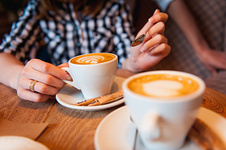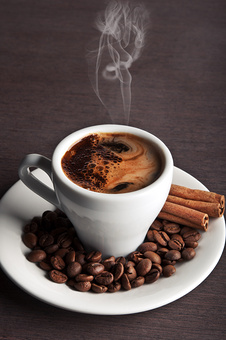Japanese coffee culture, the symbol of Japanese coffee culture
Follow the caf é (Wechat official account vdailycom) and found that Beautiful Cafe opened a small shop of its own.
The coffee shop in Kyoto is quite charming. After coming out of the Yinge Temple, you can walk across a few street corners and climb into the mountains for 20 minutes. There is a Maomao hiding in the mountains, which is a "secret shop" spread by the word of mouth of coffee maniacs. In Shu Guozhi's book "A layman's Kyoto," there is an article, "sitting in a Cafe in Kyoto," which mentions cafes in the ancient capital, some of which have been operated for decades, while others hide in the corners of historic buildings, adding some coffee aroma to the ancient capital.

Is Japanese coffee special? Or is it just the coffee shop that is special?
They are all very special, especially when they become the subject of academic research. Merry White, an anthropologist at Boston University in the United States, wrote a book called Coffee Life in Japan.
Why is Merry White interested in Japanese coffee? She pointed out several surprising facts:
1. Japan has the third largest coffee consumption in the world (after the United States and Germany)
2. Brazil, currently the world's largest coffee producer, is actually the result of cooperation between Japan and Brazil in the 19th century.
3. It is common for Japanese to drink coffee not before Starbucks was introduced, but 100 years ago. The first coffee chain in the world was born in Japan.
4.100 years ago, coffee shops have become an important living space in Japan, promoting and creating the modern era of Japanese culture.
If you are not surprised by all this, one more point is that the first cafe opened in Japan has something to do with Taiwan.
The first coffee shop in Japan
Zheng Chenggong, who opposed the Qing Dynasty and restored the Ming Dynasty, had a younger brother in Japan who had worked as a general manager (translator) in Nagasaki for generations, and his family was very important to the development of Chinese education in Japan. In the mid-18th century, Zheng Yongning, then an interpreter of the shogunate, already knew that the situation was changing. They knew that not only Chinese but also English and French were important foreign languages.
Zheng Yongning has three sons: Zheng Yongbang, Zheng Yongchang and Zheng Yongqing. Cheng Yung-pang participated in the signing of the Treaty of Shimonoseki and the cession of Taiwan; Cheng Yung-chang was also in charge of foreign affairs; and Cheng Yung-ching opened Japan's first coffee shop "whether or not Teahouse" in Tokyo in the 21st year of Meiji (1888).
When he was young, Zheng Yongqing first went to study in the United States, enrolled at Yale University, then went to London, and once studied French in Paris. Instead of taking over the family's translation career, the young Zheng Yongqing took a different path, transplanting the cafes he saw in the West to Japan.
At that time, cafes in the West gathered many intellectuals to discuss and share new knowledge. Zheng Yung-ching tried to create a new cultural space in Japan, putting a lot of books, newspapers and magazines in the teahouse, as well as displaying novelty from the West, but the atmosphere at that time was not open, and he was not good at management, and eventually went bankrupt.
The Japanese actually came into contact with coffee earlier than Zheng Yung-ching opened a cafe, but in the past coffee was used as a drug. The earliest record of coffee was the appearance of business books with the Dutch at the end of the eighteenth century. At first, people didn't know how to translate "koffie". They found the words "can", "Ke Fei", "Gu Fei", "Gu Xi" and "Jiaxi". Finally, the Japanese Chinese character was written as "Jiaqing". Later, Chinese adopted a similar usage.
Although Zheng Yung-ching did not succeed, coffee shops in Japan gradually became popular more than ten years after the closure of the teahouse. From the late Meiji era to the early Taisho era, that is, at the end of the 19th century and the beginning of the 20th century, cafes sprang up in early westernized cities such as Tokyo, Yokohama, Osaka and Kobe.
The first coffee chain in the world
The world's first coffee chain was not Starbucks in Seattle, but the Old S ã o Paulo Cafe (Cafe Paulista) opened by Mizuyolong in 1909. Mizuno was the first generation of Japanese immigrants to Brazil. At that time, Japanese immigrants mainly went to North America to help reclaim wasteland in the west. The diligence of Japanese immigrants spread to the ears of the Brazilian government, hoping to introduce Japanese immigrants to Brazil to reclaim wasteland.
About 10,000 Japanese immigrants arrived in Brazil in the late 19th century, when the price of Brazilian coffee plummeted, and Shuiyolong seized the opportunity of the times and advised the Brazilian government to promote beans to Japan.
Shuiye Dragon got a large number of free coffee beans from the Brazilian government and opened the first "Old S ã o Paulo Cafe" in Badingmu, Ginza. Because the coffee beans are quite cheap, the coffee is not expensive, attracting many college students and young intellectuals to discuss and stay here.
The coffee shop is not only a gathering place for men at this time. In addition to serving as waiters, educated female literati also go in and out of the coffee shop with men. There is also a hostess department on the second floor of the Old S ã o Paulo Cafe, where the editorial meeting of Qingta, Japan's first feminist literary magazine, was often held in 1911.
Old S ã o Paulo Cafe later opened branches in major cities in Japan, becoming the world's first coffee chain. Due to the opening of the Japanese market, on the one hand, the price of coffee in Brazil has rebounded, saving the coffee industry in Brazil; on the other hand, coffee beans in Brazil are no longer controlled by Western powers, and Japan also has a stable source of coffee beans.
Before World War II, with the increase of coffee population, not only coffee shops, but also the drinks of the general public also added coffee options, and large coffee companies, such as Key Coffee and the internationally renowned Ueshima Coffee Company,UCC Coffee, were also set up in the 1930s. UCC coffee was founded in 1933, has a history of more than 80 years, from the import of raw beans to roasting processing, and later mastered the production chain, directly into the producing area, to adjust the cultivation of tree species, picking process and price management. UCC also invented instant coffee and canned coffee, which affected the drinking habit of international coffee.
Coffee drinking in Japan can be said to be infected by the whole people, from nearby vending machines to supermarkets, although it is not a national movement, the fact that the island countries of East Asia are the third largest market for coffee consumption in the world is surprising in itself. Among Tokyo's population of more than 8 million, there are more than 80, 000 cafes, with a number of cafes on almost every street corner.
Related readings:
Adjacent to the city of Changlu Naoko, where the Ibaraki prefecture government is located, Changlunake is a local city with a population of about 150000. Take the express train from JR Tokyo Station for about 1 hour and 30 minutes to get off at JR Shengtian Station, walk for more than 10 minutes, and a semi-dome-roofed building appears in front of you. In the parking lot in front of the building marked "SAZA COFFEE" lukewarm, although it is a weekday afternoon, there are many cars parked.
Entrepreneur Yukio Suzuki is full of enthusiasm for coffee. He has opened a shop for 46 years and has all kinds of coffee, which is still favored by many customers today.
Neither a big city nor a coffee shop in a business district, offering such a wide variety of coffee drinks is a symbol of modern Japanese coffee culture and coffee shop culture.
Convenience store coffee, foreign cafes. Making the coffee market extremely hot
Important Notice :
前街咖啡 FrontStreet Coffee has moved to new addredd:
FrontStreet Coffee Address: 315,Donghua East Road,GuangZhou
Tel:020 38364473
- Prev

2017 the most complete technical term for coffee roasting
Flavor [Flavor] concatenates the above three to form a coffee impression. Some coffee has a variety of flavors, sour, sweet and bitter, while others are extremely sour, completely occupying your sense of smell and taste. There are also people who are used to using feelings to dominate judgment-does coffee have its own style? Does it have a unique forest or fruit aroma? Is your temperament gentle or masculine? Acidity [Acidity] coffee
- Next

French coffee shop culture, French coffee culture knowledge
Coffee shop culture can be traced back to the last century, this nation has just moved from the feudal imperial court culture to cosmopolitan Shanghai, where the nutrition learned from cafes began to become popular. At that time, writers such as Shi Zhecun, Mu Shiying and Liu Naou often lingered in cafes, savoring one article after another in the warm, soft, sweet and astringent aroma of coffee.
Related
- What documents do you need to go through to open a coffee shop? coffee shop coffee shop certificate processing process
- How to purchase Coffee beans in small Cafe how to choose a suitable supplier for domestic Coffee supply Company
- How to drink Starbucks Fragrance White Coffee? how to make Australian White Coffee? what Italian coffee beans are recommended?
- The Story of Flora Coffee: the name of Flora Coffee Bean and the implication of the Flowers on Florna Coffee
- How much does a cup of coffee cost? How much is the profit of a cup of coffee? What is the profit of the coffee shop in a year?
- Yunnan small Coffee, known as "fragrant Coffee", introduces the characteristics of Alpine Arabica Coffee producing areas in Yunnan, China
- 2023 latest Starbucks full menu price list how much is a cup of Starbucks coffee what is better to drink the most popular hot and cold drinks recommended
- Starbucks different kinds of Coffee Price list Starbucks menu 2023 Top Ten Best drinks in Starbucks
- Starbucks Spring praise Comprehensive matching Coffee Bean theme Story Packaging implication and taste description
- The cost of a cup of coffee latte American coffee cost price and selling price

